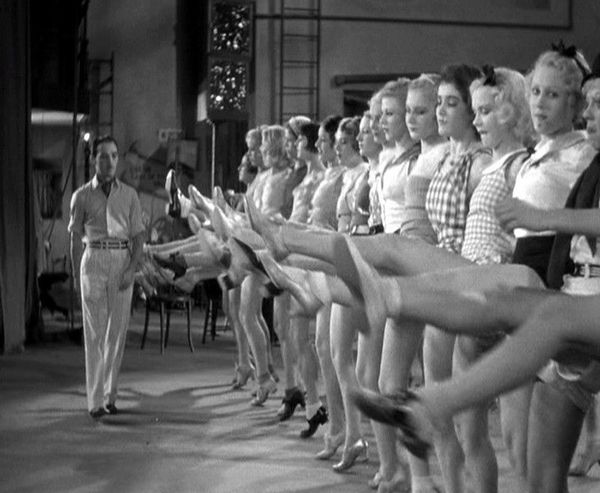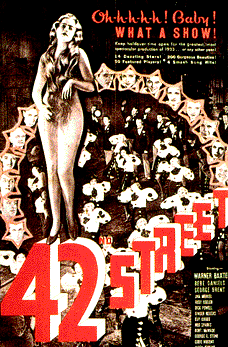Eye For Film >> Movies >> 42nd Street (1933) Film Review
42nd Street
Reviewed by: Chris

“Hollywood is a place where they'll pay you a thousand dollars for a kiss and 50 cents for your soul” - Marilyn Monroe.
Nothing dehumanises people like mass poverty. As the Great Depression bit deep into America, the struggle to survive took ugly forms. You’d risk anything to win some money and stay ahead of the pack. Thousands took up dance marathons. Thousands more turned up for auditions on the stage. They were easy pickings. That’s the way it was.

Movies took off big time as talkies replaced the silent era. Musicals had gained ground but without much polish. Then came Busby. 42nd Street is his first major work. It establishes the genre in spectacular style, breaking boundaries of perspective, camera technique, dance as spectacle and of choreography as written especially for the screen. It borrows from European surrealist film and uses stage experience but takes it to a new level. It is a defining moment as Hollywood ensures that America will dominate the film market and also defines America. 42nd Street has been called “the virtual debut of the screen musical as a viable force in Hollywood.” It was also a launching pad for an aspiring young actress called Ginger Rogers.
“How’s the turnout, Mac?” the dance director asks. And the stage manager replies, “Half are dumb and the other half are dumber.” 42nd Street is the prototype backstage musical. The young hopefuls are already dehumanised, a swarming mass of casting-couch cuties. This is not dance as if no-one is watching. Or dance for the joy of dancing. This is dance to survive - and look as if you’re enjoying it! It’s big. It’s splashy. We enjoy it.
The whole of New York eventually seems to be dancing - or at least all of 42nd Street. Every pedestrian, shopkeeper, barber, policeman, hawker, taxi driver, drunken toff or Indian. In a colossal extravaganza of three long, hot songs, there is also an attempted rape, a leap from a first floor window, a murder and chorus girls from adjacent theatres turning into skyscrapers – all without breaking time.
42nd Street is an upbeat movie released during the Depression, about the Depression. It also saved Warner Bros from bankruptcy.
Here’s the story: a naive chorus girl rises to sudden stardom on Broadway when the lead is injured. Now you’ve got that in one sentence, there’s room to concentrate on a sparkling script and a visually dazzling display on a giant scale. Hundreds of dancers - mostly attractive women - synchronised, costumed, and, erm, often scantily clad, shot in kaleidoscopic perfection from above. (Busby was famous for his “top shots” and infamous for his voyeuristic , unabashed eroticism.) Dancing girls form abstract designs and patterns for an ever more inventive camera. Even today, the effect is breathtaking - a bit like seeing ‘real stunts’ instead of CGI.
Rogers, in a relatively minor role, is noticeable for the comedic warmth that is absent or has been drained from almost every other character. She makes an entrance with a fake accent, a Pekinese puppy dog, and a monocle. The audition hall is a dog-eat-dog environment and she is quick to bite the head off of a rude competitor: “Must have been tough on your mother not having any children!”
That the women are treated as two-dimensional ‘fresh meat’ reinforces the voyeuristic, sexist gaze and also focuses our attention more keenly on the end result - jaw-droppingly beautiful patterns of female pulchritude, presented with sufficient razzmatazz (and humour from Rogers) to deflect any immediate resentment. Tawdry jokes and sexual manipulation are lighthearted offerings sacrificed at the altar of aesthetic wonderment. This dovetails with the musical-within-a-musical nicely: characters sacrifice as little as they can get away with, while promising as much as the lecherous money men can lust after. These are glitzy showgirls after all, not the chubby clodhoppers of early dance films:
Andy: “Lift your skirts up a little higher, come on, come on...Now lift your dresses up.”
Marsh: “Come on, higher, higher, I want to see the legs...Turn around.”
Andy: “Come on, turn around.”
Ginger’s character is known as “Anytime Annie”: “She only said no once and then she didn’t hear the question.” She is painted as a kind showgirl though: for some inexplicable reason sacrificing her own advancement for someone else.
42nd Street is in sharp contrast to the style of dancing most of us associate with Ginger & Fred. Busby Berkeley musicals are known for dances filmed with extravagant overhead shots and zooms on certain areas of the body - whereas Ginger’s well-known dance sequences, at Fred Astaire‘s insistence, would be captured mostly in single shot, and the dancers in full view at all times. Busby’s films use dance as spectacle, whereas Astaire was adamant that all song and dance routines were seamlessly integrated into the film’s plotlines and moved the story along. Dance as display vs dance as romance.
In 42nd Street any story is done standing still. Peggy (Ruby Keeler) is up for the lead role when the main actress drops out and needs last minute coaching to put passion into performance. “Have you ever been in love?” her new mentor asks. “Did you ever have a man hold you in his arms and kiss you?” Ruby Keeler shakes her head: He grabs her, kissing her roughly. And if such plot lines seem unacceptable, remember that the same device is used in the 2011 hit, Black Swan.
Culturally, we can see 42nd Street as an unglamorised look at the tough realities of backstage life. The crisp dialogue and street-wise put-downs strike a chord with an audience familiar with the harshness of life without a job. This doesn’t stop feminists such as Laura Mulvey complaining that “woman displayed as sexual object is the leitmotif of erotic spectacle; from pin-ups to strip-tease, from Ziegleld to Busby Berkeley, she holds the look, and plays to and signifies male desire.”
Even if we accept this, Berkeley cannot be denied the technical innovation in 42nd Street that moves cinema technique permanently forward as well as establishing - with Fred Astaire - dance musicals as the hit genre of the Thirties. (One cannot deny that Birth Of A Nation contained, in 1921, the most important cinematic developments yet seen - in spite its objectionably racist elements). Busby Berkeley loved to taunt censors and always denied any deep significance to his films, claiming that his professional ambitions were, “constant improvement and never repeating past accomplishments.”
When Peggy asks where to find the gentleman in charge, a more experienced chorus girl points her in the direction of the men’s toilet. It’s as funny as any silent slapstick classic, and only sounds different when analysed in the cold light of day. The subtexts of today’s American comedies reinforce the primacy of marriage (still predominantly white and heterosexual), the power of prayer, and miraculous happy endings if you live a good life. This one either reinforces or satirises male hegemony, depending on your point of view. Some have argued that the women attain a paradoxical power – by flashing their stockinged legs they succeed through the fetishism of mere promise.
“...I haven't got a chance of carrying this show…” says Ginger’s character - ironically, as she goes on to become a greater star than even the lead, Ruby Keeler. But being two-dimensional was never really her thing. In this or any other film.
Reviewed on: 20 Feb 2011
















